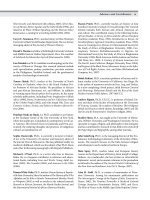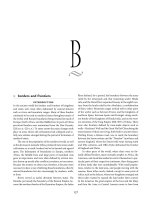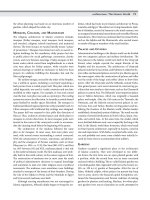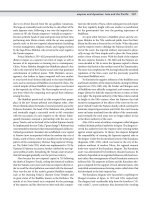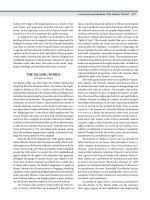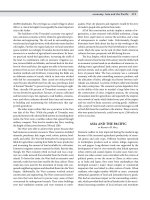Encyclopedia of society and culture in the medieval world (4 volume set) ( facts on file library of world history ) ( PDFDrive ) 596
Bạn đang xem bản rút gọn của tài liệu. Xem và tải ngay bản đầy đủ của tài liệu tại đây (66.54 KB, 1 trang )
illumination: The Islamic World 569
ally made of linen, hemp, or cotton. Of these, cotton burned
the best and soon became the dominant material. To use the
lamp the wick was floated or secured in the oil and set alight.
Lighted lamps were then placed on the table in dishes or hung
from the ceiling by chains. Lamps were used everywhere in
Europe during the Middle Ages. However, the low melting
point of candles and other tallow-coated lights meant that in
the warmer areas of southern Europe lamps were the main
source of lighting after the hearth fire.
Outdoor lighting during the period was extremely limited. It was difficult to produce a light bright enough to illuminate a sizable area for any length of time. Firelight provided
the best source of light but lacked portability. The other main
types of outdoor light were torches and cressets. Torches were
made from bundles of dried grasses and dried sticks that were
then set alight. They were highly combustible and sent off
dangerous sparks. The extent to which they were used remains
largely speculative, as they left no trace in the archaeological
record. Cressets were baskets made of metal or stone, which
were then filled with fuel such as resinous wood or oil. The
baskets were mounted on poles so that they could be carried
around. These portable forms of light were commonly used by
night watchmen on guard in villages and towns.
In the Middle Ages artificial light sources not only were
of poor quality, they were also messy and dangerous. Soot and
smoke were constant pollutants, while hot oil and molten animal wax were capable of causing serious injury. In addition,
most domestic dwellings were made of wood. This meant that
there was a constant risk of local or widespread fires. In order to minimize the damage to property and life from unattended flames, hearths had to be covered or extinguished at
a certain hour of the evening. A bell was rung to signal this
hour, which was known as the curfew. The name derives from
the Old French covre-feu, meaning literally “cover fire.”
The Islamic World
by
Kirk H. Beetz
People of the medieval Islamic world had an ambivalent relationship with sunlight. On the one hand, they depended
on the sun to provide light for working and reading, but for
much of the Islamic world, sunlight brought with it wearisome heat and blinding glare. For nomadic Muslims, these
conditions meant that they spent much of their time in their
pavilions, out of direct sunlight. Women did much of their
work within the tents, cooking and weaving. Both of these activities required an ability to see small details, implying that
lamplight was almost certainly used within the tents.
The development of Islamic architecture reflected various
efforts to come to terms with sunlight. Homes in the country
often were walled enclosures with buildings within them. The
buildings, which were homes and storage houses, might have
no windows at all, allowing for people to escape inside from
direct sunlight, or they might have small windows that allowed enough light inside for people to avoid bumping into
each other or furnishings; these windows could be covered
by curtains or shutters. In early Islamic cities homes usually
consisted of courtyards around which the living quarters
were built. Most daily activity took place in the courtyard,
which could be shaded on the edges by eaves or verandas. In
large homes of well-to-do people the courtyards were surrounded by roofed colonnades, among which people could
enjoy the benefits of shade while having enough sunlight by
which to work or to read. Medieval Muslims valued family
privacy highly, and their cities developed multistory houses,
each house with only a single door facing the street or alley
outside. There were no windows on the outside walls; instead,
windows were in the walls facing the inner courtyard. Thus,
lighting emphasized the importance of the family home over
the outside world.
The relationship of sunlight to religious observances was
similarly ambivalent. For many builders, lighting the prayer
hall was important so that people could see the direction to
Mecca and see the cleric leading prayers. The oldest great Islamic monument, the Dome of the Rock in Jerusalem, had
five windows for each side of its octagonal lower story, making a total of 40, and another 16 windows in the drum of the
dome, allowing sunlight to bathe the designs on the walls of
the interior. Lamps were added for further illumination of the
interior. Another approach was that of the Great Mosque of
Damascus (706–15). It was one of many courtyard mosques.
In these a courtyard surrounded by walls or colonnades
served as the prayer hall. Nevertheless, some designers seem
to have wanted an air of mystery in their mosques. The Great
Mosque of Córdoba is the most famous example. Its prayer
hall is a forest of pillars of varying designs. In sunlight from
high windows these pillars cast numerous shadows, darkening the walls and producing the effect of a wall-less interior,
with people inside being surrounded by infinite space.
The Koran asserts that “God is the Light of the heavens
and the earth” and compares the light of God to a lamp encased in glass in a niche, with the glass shining like a star.
Thus, lamps could symbolize the light by which God attracts
the spirits of people who wish to be good and moral. When
the Islamic world began, lamps were already the preferred
form of artificial illumination in the Near East. In Egypt
candles made of beeswax had long been made, but under the
Byzantine Empire oil lamps predominated in homes and public places. At first Muslims used the sort of lamps that were
already being made, mostly those of the Samaritans and of

